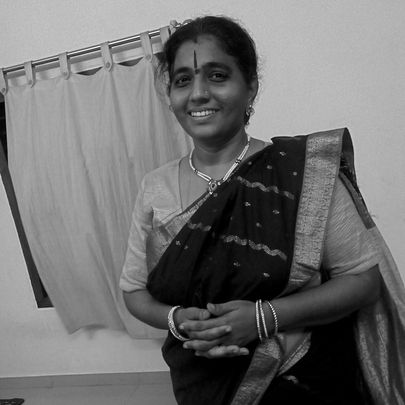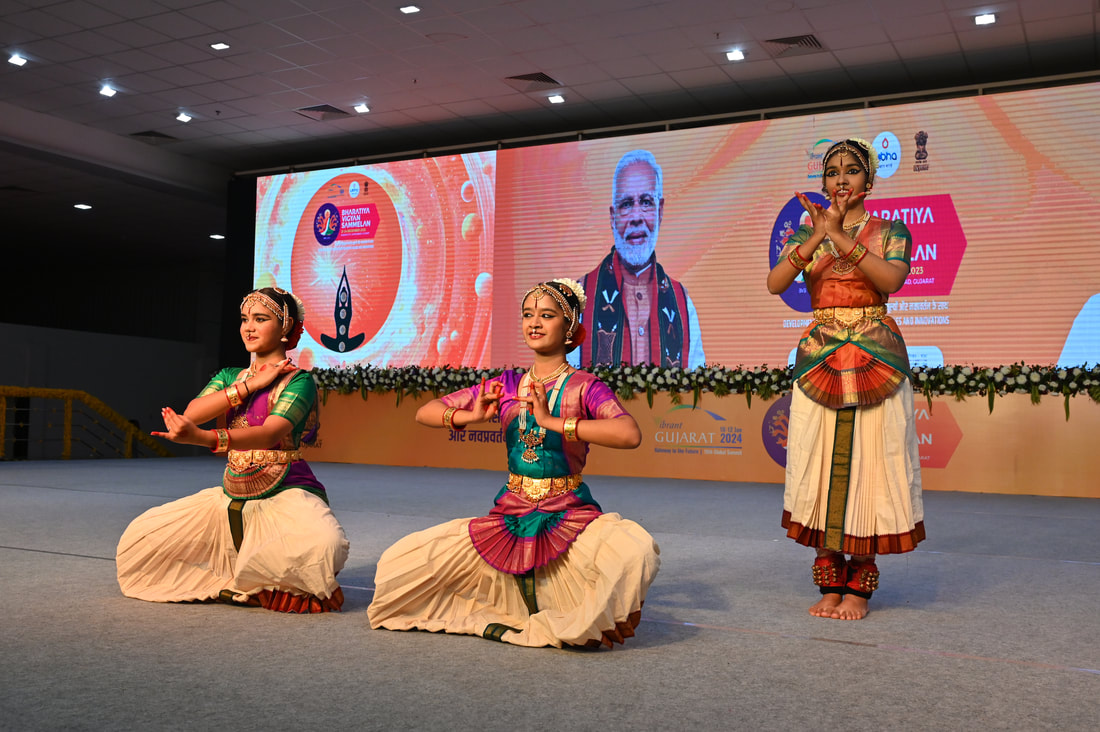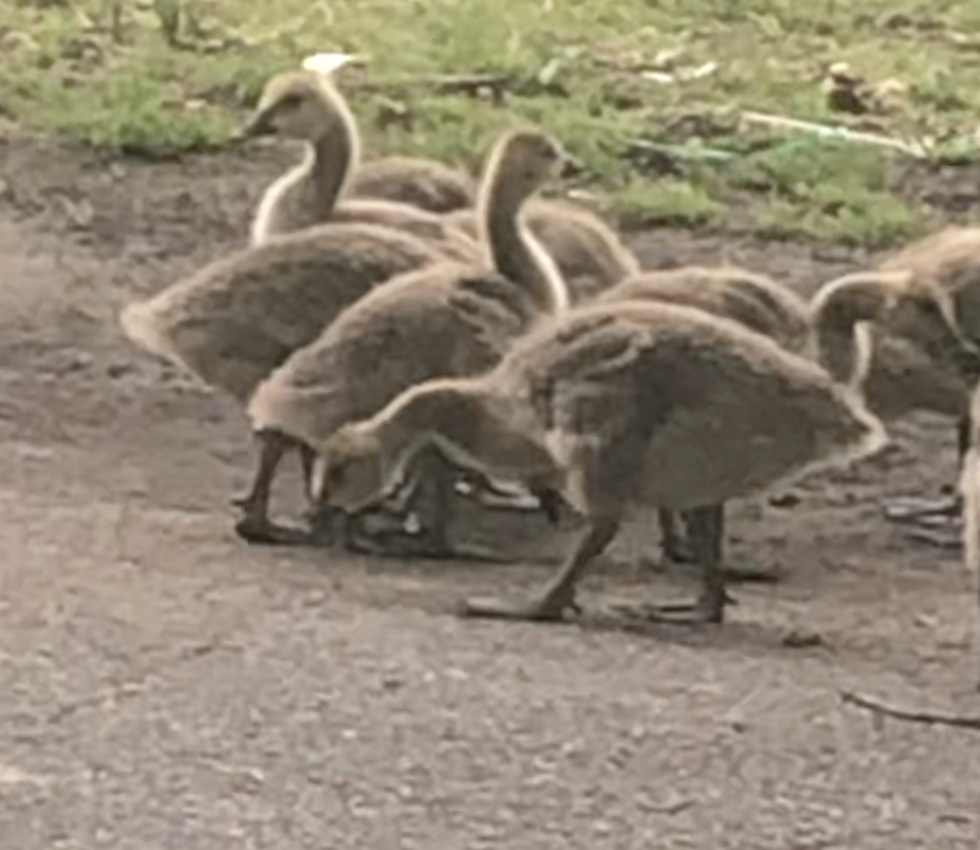A study of movement: Science and Dance at the 6th Bharatiya Vigyan Sammelan and ExpoAs the narrator (Sutradhar) for the 6th Bharatiya Vigyan Sammelan and Expo held in Ahmedabad in Dec 2023, I helped weave the dance that students of Nritya Kala Kendra did, with science. In this video, I talk about movement, and how the study of Bharatanatyam can be considered a neuroscientific study of movement. I also introduce the piece - Thillana in the ragam (melody) Behag. The transcript can be found under the video and in the close captions in the video. Transcript:
The third piece that students Nritya Kala Kendra are going to be presenting for us today is a Thillana. it is a piece that's literally a study of movement. As we know in Bharatanatyam, we have very soft subtle movements that are only (for example), of our eyes, to those are of that are movements of our eyes and the neck, to really big sweeping movements. And we'll see a variety of movements in the thillana. There's going to be a lot of poses as well, and this is an occasion for us to think of how the brain (first of all, how the brain) perceives the difference between movement and stillness as an audience or as a spectator, as well as how the brain makes movement and stillness possible. There is a new branch (or maybe a not so new branch) of neuroscience which is called neuroaesthetics, and neuroesthetics is really a field that aims to think about why we find certain works of art (whether it's visual art, performance art, arts of all kind); why we find it beautiful, and really what is happening in the brain that leads to this perception of beauty. We mentioned different kinds of movements in thillana, and in dance in general, and it is interesting to think about how the brain creates movement. While it is a topic of great discussion and study amongst the scientific community, we do know that a part of of the brain called the motor cortex is responsible for movement. The cortex is the outermost layer of our brains, and the motor cortex as the name suggests is something that is critical for movement. There are parts of the brain (again speaking to the specificity of different parts of the brain), there are parts of the motor cortex too that are responsible for initiation of movement, for planning of movement, as well as terminating the movement. So something that might appear so simple to us, for for example even taking (or) picking up a glass of water - a movement as simple as that has a lot of things that are happening in the brain to make that movement possible. This thillana is in the Ragam (or melody) Behag, and is in the talam Aadi. It has been composed - the words and the dance - have been composed by our Guru Smt. Maheshwari Nagarajan, and this is an ode to Sadguru Gyananada who is again the beacon of light and knowledge.
0 Comments
Hastas and Mudras at the 6th Bharatiya Vigyan Sammelan and ExpoAs the narrator (Sutradhar) for the 6th Bharatiya Vigyan Sammelan and Expo held in Ahmedabad in Dec 2023, I helped weave the dance that students of Nritya Kala Kendra did, with science. In this video, In this video, I talk about symbols and semiology, and talk about how the brain makes sense of (seemingly random) symbols. I link it to the hastas in Bharatanatyam. I also introduce the piece - Tridevi Stuti, where students will be praying or will be dancing to three goddesses - Goddess Lakshmi, Goddess Saraswati, and Goddess Durga. The transcript can be found under the video and in the close captions in the video. "Transcript:
We talked about the years and years that go into studying dance and science, and in these years, we are really learning the different elements of both science and dance in dance. We study different steps, we study rhythm (or talam), we look at emotions, gestures etc., and in this the piece that our students are going to perform next, I wonder if we can look and think a little bit about the gestures that we are using. Bharatanatyam students are familiar with a book called the Abhinaya Darpana which is literally translated or described as a "mirror of gestures". And one of the things that always (to this date after decades of studying Bharatanatyam) really stands out to me is how relevant Bharatanatyam is even in today's time. You know, one might wonder this is a 2,000 year old art form; what more is there to do, and hasn't everything that could be done, could be created? Hasn't that already been done? But we also know that that's not the case. And I think that's another point of commonality between the arts and the sciences where there's always more to study, there's always more to explore. Coming back to gestures, as you know, as students of Bharatanatyam, we use our hands to tell tell stories. And these stories or these gestures are called 'hastas" or "mudras" in our tradition. And we can think of them as symbols. I remember growing up in Ahmedabad, and one of my earliest memories was I hadn't yet learned how to read but I was going through a book and I was looking at these words and I was just fascinated by the shape of the words. This really led to my love for words, and thinking about how these seemingly random shapes on a piece of paper tell us something, that there's a story to be told, there's a narrative. In a similar way these hastas are giving us a narrative and and there's meaning in each of these gestures. In Bharatanatyam, we have gestures for animals for example, this is a peacock, a deer, a bird. We also have gestures for various deities. While this gesture is used to show a flute, we also know that it is used to show Krishna who is seen with a flute. A peacock, while it is can be used to show peacock (the bird), it can also be used to show Lord Kartikeya, whose vehicle is a peacock. So how does the brain make sense of these symbols around us? While in dance we have a very systematic way of thinking about the symbols, still there are symbols all around us at all times. One might think of the the Giant "M" of McDonald's and how when we see that that symbol (that icon), we know that there's a McDonald's near us. So how does the brain know what these things are, and how does the brain know how to make sense of these these symbols? When we think of reading (looking at reading or how children learn how to read or how as adults we learn to read a new language), it is a great way to understand how the brain makes sense of symbols. And studies done using MRI scans have shown the involvement of a very specific part of the brain called the ventral occipototemporal cortex - this is a part of the brain that's located in our temporal cortex (somewhere towards the back), and what scientists found using MRI scan is that as we there was also a gradient; so there was also a change with the involvement of this part of the brain (that) happened as people were learning and once they had already recognized what these symbols meant. And this gradient was that there was more activity towards the the the back portion of of this brain region, and as folks learned a particular symbol there was more activity towards the frontal part of the brain. And so even in this very specific example we can see how there's specificity in the parts of the or the part of the brain that is involved. In the piece that our students are going to do next I wonder if we can take a look at the gestures they're going to be using. This piece is called a Tridevi Stuti and students will be praying or will be dancing to three goddesses - Goddess Lakshmi, Goddess Saraswati, and Goddess Durga. As we know Goddess Lakshmi is the symbol or she is the goddess of wealth of good fortune of prosperity. Goddess Saraswati who's shown in a white sari, she is a symbol of knowledge and somebody who dispels darkness and ignorance and ego. Goddess Durga is symbolizing courage and feminine strength. This piece has also been sung by Sri Jayan Nair. The ragam - there are various ragams used - it is Ragamalika (or a garland of ragams), and the talam is Aadi. I hope you enjoy! Science and Dance at the 6th Bharatiya Vigyan Sammelan and Expo, AhmedabadAs the narrator (Sutradhar) for the 6th Bharatiya Vigyan Sammelan and Expo held in Ahmedabad in Dec 2023, I helped weave the dance that students of Nritya Kala Kendra did, with science. In this video, I introduce myself, the impetus for the work I do at the intersection of neuroscience and Bharatanatyam, the rationale for looking at the convergence of the arts and the sciences, and introduce the first piece the students performed, an ode to Lord Shiva. The transcript can be found under the video and in the close captions in the video. Transcript:
Namaste! My name is Dr Sloka Iyengar, and it is such a pleasure to welcome you all from New York City. I have the distinct pleasure of being the Sutradhar for today's show. I grew up in Ahmedabad and after my undergraduate work in Pharmacy I helped set up the first humane spay-neuter shelter for stray dogs in Ahmedabad. And in this role where I was working with hundreds of dogs every single day; working with pigeons and snakes and monkeys I really started observing keenly, animals and it is through animal behavior that led me to my interest in neuroscience I came to the US to pursue my doctoral work in neuroscience where I was looking at epilepsy and seizure disorders, and my question or my hypothesis was trying to address synaptic plasticity, which is a process by which synapses or the neurons in our brains change with experience. And my project entailed looking at how seizures and epilepsy impacted synaptic plasticity. After my PhD I came to New York where I am now for my postdoctoral work while I was where I was also looking at epilepsy and seizure disorders. had a break of several years in dance. I started learning dance when I was very young with Smt. Maheshwari Nagarajan and Smt Vanitha Jayan and after a break of several years when I came to New York I had the fortune (the good fortune) of starting to dance again. And as a practitioner of both science and dance, there were so many points of convergences between very specifically neuroscience and Bharatanatyam, but even broadly between the arts and the sciences that were really apparent to me. And in order to articulate these points of convergences, these intersections between these two seemingly disparate fields I started an online production I curate this production called Vichaar. The goals of Vichaar as I mentioned are to articulate what are the points of convergences between neuroscience and Bharatanatyam, and really thinking even more broadly about the impact of arts and sciences in the world around us. And my basic or my overarching guide of a question is to is to see if Bharatanatyam can really help us address how the brain works. So, as the Sutradhar for today, I will be announcing or introducing the items that students of Nritya Kala Kendra are going to perform. The first item is an ode to Lord Shiva. As we know Lord Shiva in his form as Nataraja is the cosmic dancer. He is the god of Dance. And you know thinking about why even look at this intersection, why should we look at the intersection of Bharatanatyam and neuroscience and arts and the sciences, and I think there's many reasons to do so.
Science and Dance at the 6th Bharatiya Vigyan Sammelan and Expo, AhmedabadAs the narrator (sutradhar) for the 6th Bharatiya Vigyan Sammelan and Expo held in Ahmedabad in Dec 2023, I helped weave science with the dance pieces performed by students of Nritya Kala Kendra. Below are a few videos and an image from the event.
Future posts will show the specific ways in which I linked neuroscience and Bharatanatyam in this event. Smt Vanitha Jayan ("Didi") In addition to Amma, another deep influence in my life as a practitioner of dance has been Smt. Vanitha Jayan (“Didi”). Her knowledge of philosophy, symbolism, her progressive outlook towards dance are all things that make me excited to share my love of dance with others. Her emphasis on the fact that books like the Natya Shastra and other texts are meant to enable creativity - not stifle it - remains one of the guiding principles of my work. Teaching Bharatanatyam out of the Indian context comes with a lot of forethought for me, and Didi remains my constant connection to what’s “allowed” vs. what is not. In her view, Bharatanatyam gives us the vocabulary to explore topics and issues that may be traditional or contemporary. In addition to dance, I remember times when Didi and I would tour old Ahmedabad city to get fabrics for an upcoming production and eat water chestnuts (Singhara) on the way. Didi is also a big proponent of including one’s local environment and current events in dance, which has led to her choreographing pieces written by Narsingh Mehta, and other pieces in Gujarati. Didi is certainly one of my biggest supporters and inspiration to use Bharatanatyam for creative aging. |
About SlokaMy name is Sloka. I am a neuroscientist and Bharatanatyam dancer; you can find more about me here. Archives
June 2024
|

